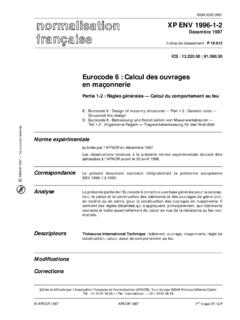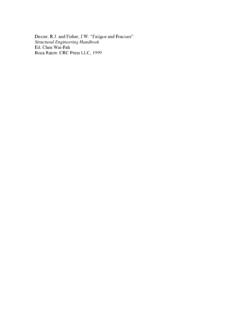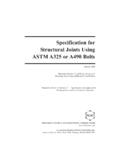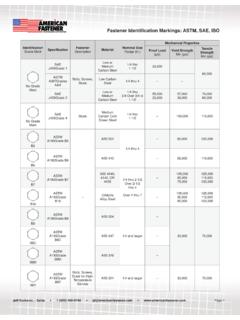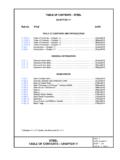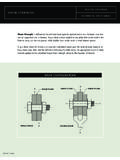Transcription of Structural Steel Design - Free
1 Lui, Structural Steel Design . Structural Engineering Handbook Ed. Chen Wai-Fah Boca Raton: CRC Press LLC, 1999. Structural Steel Design 1. Materials Stress-Strain Behavior of Structural Steel Types of Steel Fire- proofing of Steel Corrosion Protection of Steel Structural Steel Shapes Structural Fasteners Weldability of Steel Design Philosophy and Design Formats Design Philosophy Design Formats Tension Members Allowable Stress Design Load and Resistance Factor Design Pin-Connected Members Threaded Rods Compression Members Allowable Stress Design Load and Resistance Factor Design Built-Up Compression Members Flexural Members Allowable Stress Design Load and Resistance Factor Design Continuous Beams Lateral Bracing of Beams Combined Flexure and Axial Force Allowable Stress Design Load and Resistance Factor Design Biaxial Bending Allowable Stress Design Load and Resistance Factor Design Combined Bending, Torsion.
2 And Axial Force Frames Plate Girders Allowable Stress Design Load and Resistance Factor Design Connections Bolted Connections Welded Connections Shop Welded- Field Bolted Connections Beam and Column Splices Column Base Plates and Beam Bearing Plates (LRFD. Approach). Column Base Plates Anchor Bolts Beam Bearing Plates Composite Members (LRFD Approach). Composite Columns Composite Beams Composite Beam- Columns Composite Floor Slabs Plastic Design Plastic Design of Columns and Beams Plastic Design of E. M. Lui Beam-Columns Department of Civil and Environmental Engineering, Defining Terms Syracuse University, References . Syracuse, NY Further Reading 1 The material in this chapter was previously published by CRC Press in The Civil Engineering Handbook, Chen, Ed., 1995. c1999 by CRC Press LLC. Materials Stress-Strain Behavior of Structural Steel Structural Steel is an important construction material.
3 It possesses attributes such as strength, stiffness, toughness, and ductility that are very desirable in modern constructions. Strength is the ability of a material to resist stresses. It is measured in terms of the material's yield strength, Fy , and ultimate or tensile strength, Fu . For Steel , the ranges of Fy and Fu ordinarily used in constructions are 36 to 50 ksi (248 to 345 MPa) and 58 to 70 ksi (400 to 483 MPa), respectively, although higher strength steels are becoming more common. Stiffness is the ability of a material to resist deformation. It is measured as the slope of the material's stress-strain curve. With reference to Figure in which uniaxial engineering stress-strain curves obtained from coupon tests for various grades of steels are shown, it is seen that the modulus of elasticity, E, does not vary appreciably for the different Steel grades.
4 Therefore, a value of 29,000 ksi (200 GPa) is often used for Design . Toughness is the ability of FIGURE : Uniaxial stress-strain behavior of Steel . a material to absorb energy before failure. It is measured as the area under the material's stress-strain curve. As shown in Figure , most (especially the lower grade) steels possess high toughness which is suitable for both static and seismic applications. Ductility is the ability of a material to undergo large inelastic, or plastic, deformation before failure. It is measured in terms of percent elongation or percent reduction in area of the specimen tested in uniaxial tension. For Steel , percent elongation c1999 by CRC Press LLC. ranges from around 10 to 40 for a 2-in. (5-cm) gage length specimen. Ductility generally decreases with increasing Steel strength. Ductility is a very important attribute of Steel .
5 The ability of Structural Steel to deform considerably before failure by fracture allows an indeterminate structure to undergo stress redistribution. Ductility also enhances the energy absorption characteristic of the structure, which is extremely important in seismic Design . Types of Steel Structural steels used for construction purpose are generally grouped into several major American Society of Testing and Materials (ASTM) classifications: Carbon Steels (ASTM A36, ASTM A529, ASTM 709). In addition to iron, the main ingredients of this category of steels are carbon (maximum content = ) and manganese (maximum content = ), with a small amount (< ) of silicon and copper. Depending on the amount of carbon content, different types of carbon steels can be identified: Low carbon Steel carbon content < Mild carbon Steel carbon content varies from to Medium carbon Steel carbon content to High carbon Steel carbon content to The most commonly used Structural carbon Steel has a mild carbon content.
6 It is extremely ductile and is suitable for both bolting and welding. ASTM A36 is used mainly for buildings. ASTM A529. is occasionally used for bolted and welded building frames and trusses. ASTM 709 is used primarily for bridges. High Strength Low Alloy Steels (ASTM A441, ASTM A572). These steels possess enhanced strength as a result of the presence of one or more alloying agents such as chromium, copper, nickel, silicon, vanadium, and others in addition to the basic elements of iron, carbon, and manganese. Normally, the total quantity of all the alloying elements is below 5% of the total composition. These steels generally have higher corrosion-resistant capability than carbon steels. A441 Steel was discontinued in 1989; it is superseded by A572 Steel . Corrosion-Resistant High Strength Low Alloy Steels (ASTM A242, ASTM A588).
7 These steels have enhanced corrosion-resistant capability because of the addition of copper as an alloying element. Corrosion is severely retarded when a layer of patina (an oxidized metallic film). is formed on the Steel surfaces. The process of oxidation normally takes place within 1 to 3 years and is signified by a distinct appearance of a deep reddish-brown to black coloration of the Steel . For the process to take place, the Steel must be subjected to a series of wetting-drying cycles. These steels, especially ASTM 588, are used primarily for bridges and transmission towers (in lieu of galvanized Steel ) where members are difficult to access for periodic painting. Quenched and Tempered Alloy Steels (ASTM A852, ASTM A514, ASTM A709, ASTM. A852). The quantities of alloying elements used in these steels are in excess of those used in carbon and low alloy steels.
8 In addition, they are heat treated by quenching and tempering to enhance their strengths. These steels do not exhibit well-defined yield points. Their yield stresses are determined by the offset strain method. These steels, despite their enhanced strength, have reduced ductility c1999 by CRC Press LLC. (Figure ) and care must be exercised in their usage as the Design limit state for the structure or Structural elements may be governed by serviceability considerations ( , deflection, vibration). and/or local buckling (under compression). FIGURE : Frequency distribution of load effect and resistance. In recent years, a new high strength Steel produced using the thermal-mechanical control process (TMCP) has been developed. Compared with other high strength steels, TMCP Steel has been shown to possess higher strength (for a given carbon equivalent value), enhanced toughness, improved weldability, and lower yield-to-tensile strength ratio, Fy /Fu.
9 A low Fy /Fu value is desirable because there is an inverse relationship between Fy /Fu of the material and rotational capacity of the member. Research on TMCP Steel is continuing and, as of this writing, TMCP Steel has not been given an ASTM designation. A summary of the specified minimum yield stresses, Fy , the specified minimum tensile strengths, Fu , and general usages for these various categories of steels are given in Table Fireproofing of Steel Although Steel is an incombustible material, its strength (Fy , Fu ) and stiffness (E) reduce quite noticeably at temperatures normally reached in fires when other materials in a building burn. Exposed Steel members that will be subjected to high temperature when a fire occurs should be fireproofed to conform to the fire ratings set forth in city codes. Fire ratings are expressed in units of time (usually hours) beyond which the Structural members under a standard ASTM Specification (E119).
10 Fire test will fail under a specific set of criteria. Various approaches are available for fireproofing Steel members. Steel members can be fireproofed by encasement in concrete if a minimum cover of 2. in. (51 mm) of concrete is provided. If the use of concrete is undesirable (because it adds weight to the structure), a lath and plaster (gypsum) ceiling placed underneath the Structural members supporting the floor deck of an upper story can be used. In lieu of such a ceiling, spray-on materials such as mineral fibers, perlite, vermiculite, gypsum, etc. can also be used for fireproofing. Other means of fireproofing include placing Steel members away from the source of heat, circulating liquid coolant inside box or tubular members and the use of insulative paints. These special paints foam c1999 by CRC Press LLC.


